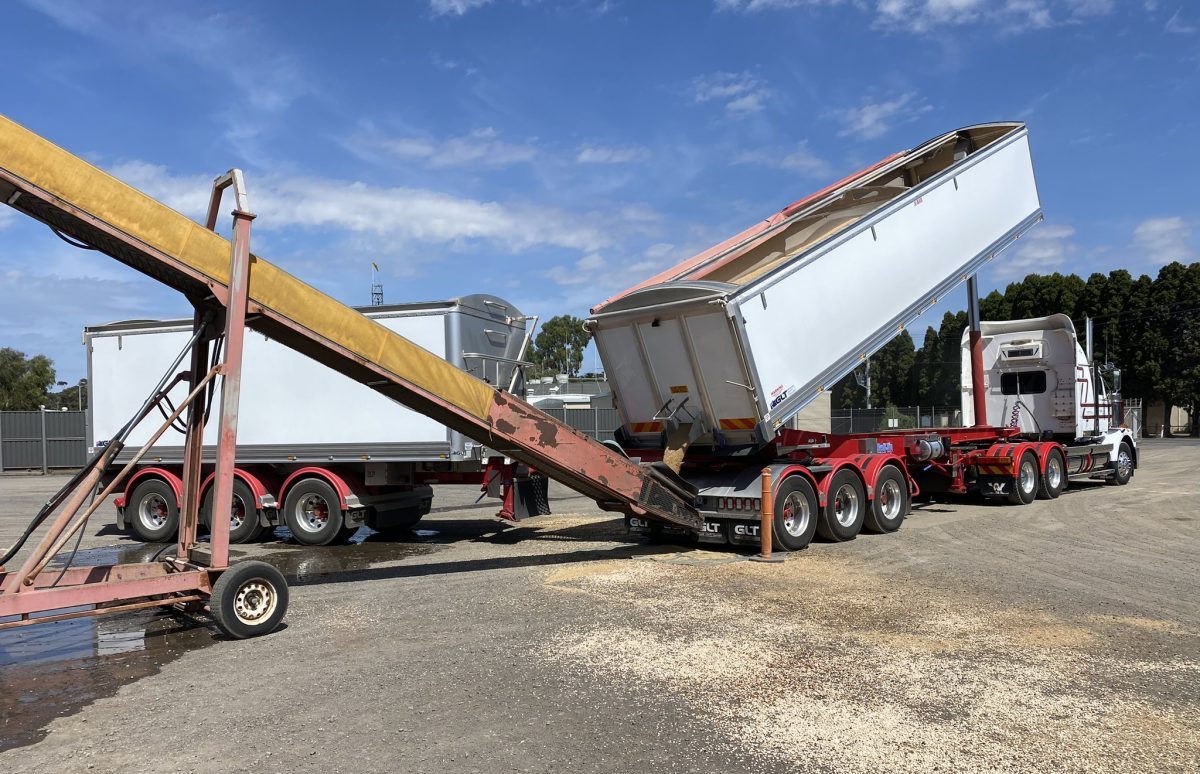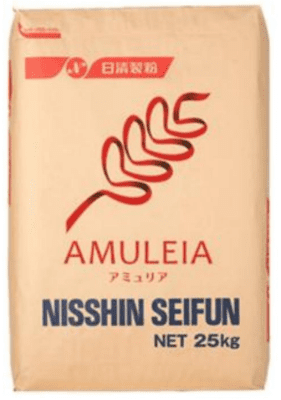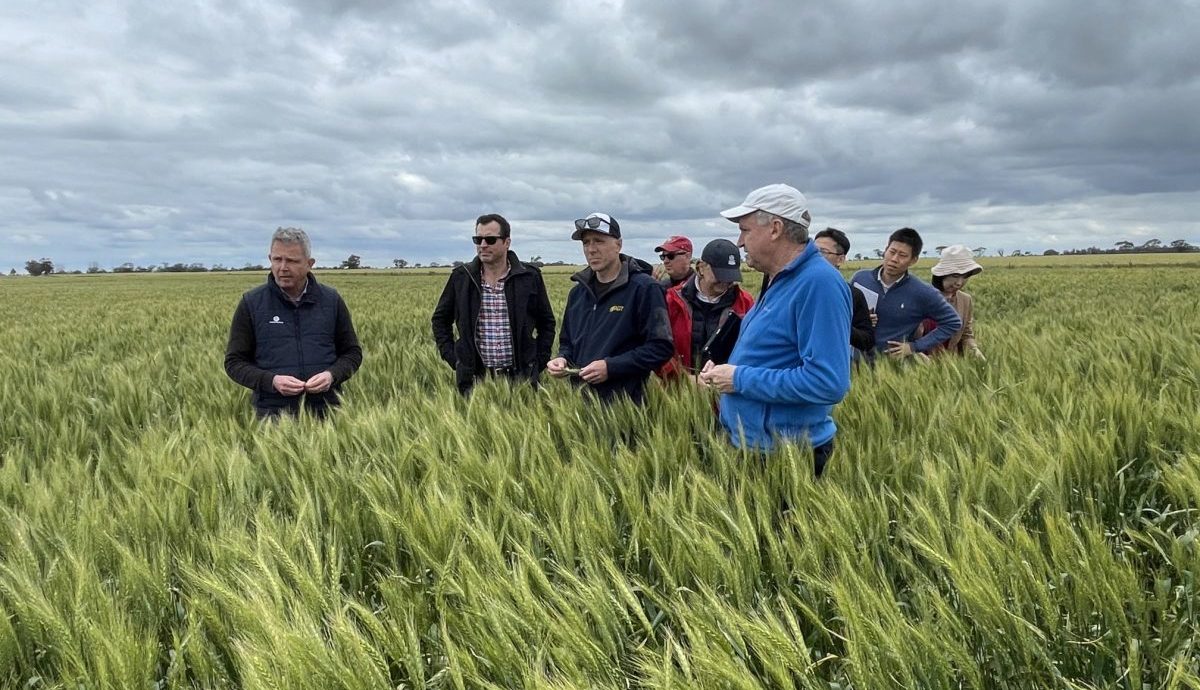i thought TFL Folk might find this Australian / Japanese story interesting as i did
Saturday 6 May 2023A A A Search MARKETSHigh-amylose wheat sets sail for JapanEmma Alsop, March 6, 2023





High-amylose wheat is augered into a hopper for container loading ahead of export last month. Photo: Ryan Milgate
A PARTNERSHIP between Australian entities and Japan’s Nisshin Flour Milling has culminated in the first shipment of high-amylose wheat being shipped out of Victoria.
The shipment marks the next step of a flourishing project designed to grow markets for this Australian-developed novel wheat variety and provide improved returns to growers.
Nisshin Flour Milling was the first company to purchase container-loads of the wheat, which will be the base of Japan’s first high-fibre wheat-flour product, Amulia, launched last week.
Nisshin owns Australia’s Allied Mills which will soon to be the project’s second customer, having contracted to buy 500-600t of the current crop.
The project was kick started by CSIRO, which collaborated with Australian Grain Technologies and AGT stakeholder French company Limagrain to develop a variety suited to Australian growing regions that offered higher amylose or dietary-fibre content to food companies and consumers.
Limagrain and CSIRO formed a joint-venture company, Arista Cereal Technologies, to increase market access for this novel ingredient and open up discussions with foreign manufacturers.

Nisshin’s new flour product made using the high-amylose wheat. Photo: Nisshin
Victorian-based agribusiness Farm Trade Australia recently joined the project to facilitate the uptake of the variety by growers and arrange delivery and packaging of the wheat into containers.
The high-amylose wheat project was the first commercial venture for the farmer-owned agribusiness which was formed to provide a framework to help growers collaborate on larger-scale projects and receive a greater share of returns for their work.
FTA founder and Rupanyup farmer David Matthews said there was strong grower interest in the project from the beginning.
Mr Matthews said AGT approached him in April 2022 looking for a partner to work with growers to produce the 3000t required by Nisshin Flour Milling.
He said this was “a significant lift” on any of the previous orders.
“Within a week or so we had 11 farmers in western Victoria, who were willing to try and grow this variety,” Mr Matthews said.
“A lot of farmers are real innovators and if they see something that has merit, they will adopt very quickly.”
He said the growers planted about 1000ha of the variety, which was then stored on-farm or at a designated delivery point before being trucked to a packing facility at Lara, near Geelong.
As part of the project, growers also received compensation for on-farm storage or trucks that were used to transport the grain to the packing facility.
Mr Matthews said this model offered growers a return for playing a bigger part in the supply chain.
“Often farmers don’t really price their on-farm storage, or their freight commercially.
“Within this model, we build in a commercial storage fee for farmers to store it and then commercial freight for the farmers who deliver it into the packing plant.
“It’s really moving them from just producing it to benefiting from some of that ex-farmgate functions as well.”
Exceeded expectations
Victoria’s Ryan Milgate, a mixed farmer from Minyip in the Wimmera-Northern Grampians region, was one grower who took part in the project last season.
Mr Milgate planted about 140ha of the variety and said it performed better than he predicted.
“I think last year we had a really good season for it, and it has actually exceeded expectations mostly on yield and we got the quality we needed comfortably,” Mr Milgate said.
“Essentially the management is the same as growing any other milling wheat… we didn’t do anything special.”
Mr Milgate said he was eager to get involved in a project that allowed him to grow an innovative new variety.
“It is an exciting thing to be involved in.
“I am looking at growing it again and I think everyone that grew it is looking at going again.”

Representatives from Nisshin Flour Mills and Allied Mills met with growers to discuss the production of high-amylose wheat. Photo: David Matthews
Double production this year
Thanks to interest from growers and customer demand, Mr Matthews said he is preparing to double production this season.
“We will be looking to double that production in 2023, and in doing that, we will start to build some geographic diversity in the production to protect against seasonal issues.
“We’ll have production in north-east Victoria and southern NSW as well.
“We will look to include another 10 or so farmers in that area and really continue to build out the project.”
Mr Matthews predicts that the high-amylose wheat product will draw interest from other global markets.
“We acknowledge that Nisshin has been doing a lot of development work on this for a long time and they’ve had to commit a lot of time and energy and money into getting to this point.
“But, obviously, this won’t be just confined to one country.
“It is…likely to have global reach, so the project could be a significant one for farmers in Australia.”
New varieties in pipeline
AGT led the first commercial release of the high-amylose wheat variety, known as HAW1, in 2020.
While most growers have had success with HAW1, AGT acknowledged that the grain size can be smaller and yields up to 20pc less than other milling wheat varieties.
It is also better adapted to NSW and Victorian growing regions.
Currently, growers are offered a premium to compensate for lower yields.
However, AGT is working to produce a new variety, which will have results in line with other milling varieties.
“We are working on improved varieties and we are likely to have a new one, which we will switch over to in the coming couple of years,” AGT head of science and business development Tristan Coram said.

AGT’s Tristan Coram
“It will have a big improvement in yields and overall package for disease resistance.”
Mr Coram said he hoped the new varieties will be adapted to a wider range of growing regions, adding to the diversity of production and giving growers the option to irrigate if needed.
HAW1 was the first variety to be included in the new wheat quality classification, Australian Innovative Wheat, announced in April 2022.
Mr Coram said AGT aimed to add new varieties to this classification in coming years and continue to work with farmers and agribusinesses to create new, value-added markets for Australian grains.
Consumer demand driven production
Mr Matthews said the success of the high-amylose wheat project and the partnerships formed between growers, agronomists, food companies and AGT has demonstrated the benefits of this farming model.
He said FTA was currently working to get more projects off the ground that can provide growers with more value for their efforts.
“It does, I think, step away from that sort of commodity mentality where with commodities, like our normal milling wheat, we’re just competing against the lowest cost producers in the world.
He said this wheat was created based on consumer demands rather than growing a commodity in the hope that people with buy it.
“Consumers have so much more control now.
“Instead of a supply-led approach in agriculture where we grow a lot of stuff and sell it to the highest bidder, this is an example of a demand-led production model where it is the consumer demand we are responding to.
“It’s a flip in the way we traditionally approached our model of production in Australia.
“I think it’s an essential part of the evolution that we sort of undergo on our farms and the grains industry.”
kind regards Derek
How does it affect bread quality, Derek?
Patsy
Hi Patsy i dont know yet perhaps some of our clever people might be able to shed a light on that mean while i will try to find out more here regards Derek
here is a good link
https://draxe.com/nutrition/amylose/
Great initiative and looks like a winner for those involved. Love reading this post.
Gavin
Did some online reading and it says that bread made with these flours is lower GI and consequently improves blood sugar management.
I do wonder if the amylose is in the endosperm too and if there is a benefit with sifted flour or not.
I'm sure if you emailed them that very question Jon they would be impressed to hear from South Africa
i was able to make contact with the gentleman holding test breads but unfortunately their is some client confidentiality issues so not able to get a lot more info or a follow up story. Tristan was able to confirm that it does make a reasonable loaf of bread but it is the digestable fibre that is its key asset.
As a USA transplant many years from Australia, one thing I really miss is Australian bread. Its pretty well known that if you the quintessential bread experience then go to France as there is no competition but to be fair, Australian bread made from aussie flour is a total treat and at least in this guys experience is a rival to french bread. The flavor profile of bread, pastries and pizza in Australia is really high end so this is a great article and making me want to get my hands on some !
Hi Kendalm Thankyou for your kind and high praise words regarding Australian bread and flours. i do think we have come a long way from when i was an apprentice baker and the little bit that we did learn about flour and milling and wheat production . Back then it was built around "Fair Average Quality" there was no premium paid for some of the lower yielding but better tasting varieties. Now with a focus more on on what customers want things have changed for the better here is an interesting article on who buys our wheat.
This is from Grain Central newsletter
Australia exports record 3.8Mt wheat in MarchLiz Wells, May 5, 2023Wheat being delivered direct to vessel at Cargill’s Port Adelaide facility in March. Photo: Leigh Fuller
AUSTRALIA exported 3,785,436 tonnes of wheat and durum in March, up 25 percent from 3,038,804t shipped in February, according to the latest data from the Australian Bureau of Statistics.
The figure is believed to set a new monthly record for Australian wheat exports.
In containerised exports, China on 96,070t and Vietnam on 80,458t were the biggest markets for March shipments by far, with Thailand on 34,495t in third place.
Total containerised exports of wheat in March at 314,857t were up a hefty 40pc from the February total, with the China figure up 69pc and accounting for 39,334t and much of the lift.
Containerised shipments to The Philippines, Taiwan and Thailand also jumped by more than 50pc.
Ahead of the UK-Australia Free Trade Agreement coming into effect, containerised wheat exports posted almost tripled to 3957 in March, up from 1370t in February, and much less in preceding months.
In bulk exports, China’s appetite for Australian wheat seems to know no bounds, and at 1,038,798t was up 59pc from the 651,788t shipped in February.
The second-biggest market for bulk Australian wheat exported in March was Indonesia on 317,148t, followed by Vietnam on 306,172t.
Thailand on 291,947t, The Philippines on 290,126t and South Korea on 280,092t were also major volume buyers.
Bulk export figures include the two biggest durum cargoes for the current marketing year, with 21,838t heading to Italy and 31,500t bound for Spain.
Australian containerised wheat and durum exports from 1 October 2022 to 31 March 2023. Source: ABS
Australian bulk wheat and durum exports from 1 October 2022 to 31 March 2023. Source: ABS
Grain Central: Get our free news straight to your inbox – Click here
another article that you may find interesting from the same people is this link
https://www.graincentral.com/ag-tech/grain-ai-zoomagri-brings-insights-to-barley-id/?utm_medium=email&utm_campaign=Grain%20Central%20News%20Hea….
Kendalm you may want to subscribe to the newsletter some very interesting stuff comes through.
I and Gavin in Victoria are busy at the present working on using Australian Sweet Lupin flour and flakes in bread for its many health benefits.
kind regards Derek